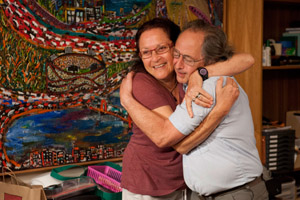October 21, 2013 - By Tracie White
It came as no surprise to Gertrude Levitt that her son became a scientist. From an early age, she recalled, he had a burning desire to figure out how things worked. He was constantly taking things apart and putting them back together, building extravagant models out of Tinkertoys and, occasionally, blowing things up.
"He took glycerin, from my medicine closet, and potash from somewhere, mixed them together and put them on my beautiful parquet floor and ignited it," said Gertrude, 98, who lives in London. "It exploded. I wasn't very pleased. It blew a hole in the floor."
Since then, it's safe to say that Michael Levitt's scientific curiosity and aptitude have developed in more productive directions. Indeed, the Stanford professor of structural biology was quite happy to share his latest accomplishment with his mother: When he got a call from Stockholm Oct. 9 at 2:11 a.m., informing him that he had been awarded the Nobel Prize in Chemistry, she was the first person he called.
Watch as Michael Levitt, PhD, handles the multitude of phone calls, emails, interviews and parties during his first day as a Nobel Prize winner.
"I think I'm a very, very fortunate person that I'm still alive to see this day," Gertrude said, adding that she definitely plans to accompany him to the award ceremony in Stockholm.
The Royal Swedish Academy of Sciences awarded the prize to Levitt, 66, "for the development of multiscale models for complex chemical systems." The Robert W. and Vivian K. Cahill Professor in Cancer Research at the School of Medicine, Levitt, PhD, shares the $1.2 million prize with Martin Karplus, PhD, of the University of Strasbourg and Harvard University, and Arieh Warshel, PhD, of the University of Southern California.
It's the first time a Nobel has been awarded to scientists who excel at exploring the virtual world of complex chemical reactions in biomolecules. Karplus, 83, and Warshel, 72, and Levitt pioneered the field of computational biology that emerged out of the 1960s and 1970s, when personal computers were virtually nonexistent and chemistry was supposed to be done in a white lab coat using test tubes.
"Computer models mirroring real life have become crucial for most advances made in chemistry today," according to the Nobel Prize website.
After calling his mother, Levitt updated his Facebook page. Ear glued to his cell phone, he paced around the small bedroom he shares with his wife, Rina, chatting excitedly with the national and international press for many hours.
"Programmers didn't really exist in those days," he said, talking into a cell phone in his condominium unit, on the Stanford campus, barefoot and babbling a bit, press vans waiting outside in the dark. "One had to write programs on punch cards using a computer that occupied a whole floor of a large building."
Later, he added, "The only big change in my life is that I need to learn how to dance. When you go to Stockholm, you have to do ballroom dancing. But I am sure I will handle that hurdle as well."
Finally, he clicked off the phone. He paused a moment to compose himself. Then, the self-described computer geek left the safety of the bedroom and stepped out the door into the onslaught of camera lights awaiting him.
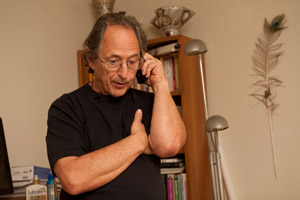
After learning of his Nobel Prize, Levitt spoke with friends, family and journalists from his home on Stanford's campus.
Later that morning, Levitt told press, colleagues, friends and fans, who filled an auditorium on the medical school campus, that his groundbreaking research started when he was a 20-year-old predoctoral scholar at the Weizmann Institute in Israel and continued as a PhD student in Cambridge, England, working mostly from home and looking after his newborn child amid stacks of computer punch cards and molecular models. It was then that he began building the foundational software algorithms that now allow researchers to simulate complex biological processes within the body.
"There weren't really computers available in the '60s," Levitt said. "I liked computers. My wife would say that I love computers. Did she get up and leave?" he said to laughter, looking around the audience. "She's lived with me now 46 years. That's pretty impressive."
He and his wife have three sons, all born during their years at Cambridge, and now three grandchildren. He hopes to bring Barak, his 10-year-old grandson, with him when he visits the White House with the other new U.S. Nobel laureates.
Born in South Africa — his Austrian grandfather chose the spot by closing his eyes and sticking a pin in a world map — Levitt speaks with a slight accent, holds South African, British and Israeli citizenships, and like his co-winners is a naturalized American citizen.
He excelled early on as a scholar, graduating from high school at the age of 15 and gaining a degree in physics from King's College in London in 1967. He completed a PhD in computational biology at Cambridge University in 1971.
He graduated early from high school at the behest of his mother, Levitt said. "One night at 15 years old, I was out with friends playing billiards. I came back at 6 a.m., which was really late. My mother was really mad at me. She sort of grounded me. She basically said, 'Obviously school isn't very exciting for you. If you've got so much time, why don't you skip two years of school.'"
So, Gertrude hired a tutor, and over his three-month summer vacation he completed two years of school. "Within a year I went from 10th grade to being in university in England," Levitt said. "I went from being a schoolboy to being a husband with a son in six years. It was really a whirlwind period."
After graduating from King's College, Levitt hoped to do his doctoral work at the Medical Research Council Laboratory of Molecular Biology in Cambridge. He said he had been "enthralled" by John Kendrew's 1964 BBC television series The Thread of Life. Kendrew had received the Nobel Prize in Chemistry in 1962 for determining the structure of myoglobin using X-ray crystallography; The Thread of Life was an introduction to the concepts of molecular biology.
But the Laboratory of Molecular Biology then could not accommodate any more graduate students, so he planned to begin attending the following year. In the interim, he was sent by Kendrew, who was on faculty at Cambridge, to study in the laboratory of Shneior Lifson, PhD, at the Weizmann Institute in Israel, where he first met Warshel, then a PhD student and now a fellow Nobel laureate. At the institute, he was immediately plunged into the new fields of structural biology and computers. While there he also met Rina, his soon-to-be Israeli wife. They married just before moving to Cambridge.
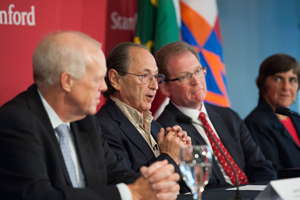
Levitt (second from left) speaks to reporters at an Oct. 9 press conference. He was joined by (from left) Stanford President John Hennessy, School of Medicine Dean Lloyd Minor and Jennifer Widom, chair of computer science.
At that time, computing at the Weizmann Institute was amongst the best in the world. The computer at the institute, a machine custom built in 1963, was called Golem, after an artificial creature in Jewish folklore. "Whereas computers now have memory capacities measured in gigabytes, the memory of my first machine was less than 1 megabyte," Levitt said. "Nothing is that slow. It was thousands of times slower than the cheapest machines today."
Working together, Levitt and Warshel designed a computer program that was capable of performing the first energy-minimization calculations of entire protein structures. The first two proteins analyzed were myoglobin and lysozyme. In 1969, Warshel took the computer program with him to the Karplus laboratory at Harvard. From 1973 to 1975, Warshel and Levitt refined their program, integrating quantum mechanics in order to simulate chemical reactions in enzymes like lysozyme. In 1976, Karplus and co-workers first simulated protein dynamics, an advance that Levitt credited in a Nature Structural Biology article.
Levitt applied these same programs to proteins, setting the stage for an entirely new way to predict how proteins fold and interact. At that time, X-ray crystallography was used to ascertain the location of atoms like carbon, nitrogen and oxygen in larger molecules, such as proteins or DNA. Researchers then used the data to construct large, three-dimensional models out of plastic balls and metal sticks in order to better understand what the molecules looked like and how they might work.
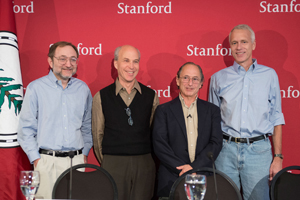
Four of the six living Nobel laureates at the medical school -- Andrew Fire, Kornberg, Levitt and Brian Kobilka -- attended the Oct. 9 press conference for Levitt.
At Cambridge, he studied the structure of a molecule called transfer RNA, which helps build proteins inside the body, using the bulky, three-dimensional, ball-and-stick model popular at the time.
"Transfer RNA has almost 2,000 atoms and a space-filling model weighs over 100 pounds. My most vivid memory is lowering the tRNA CPK model from the first floor window of our terrace cottage in Newnham, while my somewhat pregnant wife was having a hard time controlling her laughter," wrote Levitt in the Nature Structural Biology article, recalling how the model "towered over" him. There had to be a better way.
He remembers those early transformative years at Cambridge fondly, but also as a time of struggle for the entire family.
"I was basically about 20 years old, but I looked like I was 14. We had kids, but no money. Rina went out and worked. She had studied biology and got a job in a lab. I worked at home. Somehow, we managed it."
Levitt returned to the Weizmann Institute as a postdoctoral scholar from 1972 to 1974. He studied with Francis Crick at the Salk Institute from 1977 to 1979, then returned to Weizmann as a faculty member until coming to Stanford in 1987.
At Stanford, Levitt is a member of Bio-X, the interdisciplinary initiative housed in the Clark Center. "There's no doubt that interdisciplinary research has been a very great thing, and Stanford is very lucky to have been at the beginning of it," he said. "The Clark Center has been super-important in encouraging these interdisciplinary interactions."
Levitt credits his family, particularly his wife, a sculptor, for supporting him. He recently assisted Rina in her design of a two-dimensional wire sculpture called Unity for the 2013 Burning Man festival in Nevada.
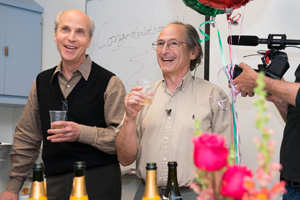
Roger Kornberg, left, who won the Nobel Prize in Chemistry in 2006, celebrates this year's winner of that prize — his colleague Levitt.
"I am a very passionate scientist, but passionate scientists often make very bad husbands," he said. "I have my two passions: one is science, one is Rina. I was just lucky. I could have messed up in so many ways."
Together the couple celebrated the award's announcement with a champagne party on Oct. 9 in the same conference room where, in 2006, Roger Kornberg celebrated winning his own Nobel Prize in Chemistry.
"When your best friend wins the award you have to enjoy the day," said Kornberg, PhD, professor of structural biology and the Mrs. George A. Winzer Professor in Medicine. "I regard Michael as the founder of computational biology, the leading figure in the field. He is a gem of a person. You will never find a more generous or modest individual. He has long deserved it."
About Stanford Medicine
Stanford Medicine is an integrated academic health system comprising the Stanford School of Medicine and adult and pediatric health care delivery systems. Together, they harness the full potential of biomedicine through collaborative research, education and clinical care for patients. For more information, please visit med.stanford.edu.
